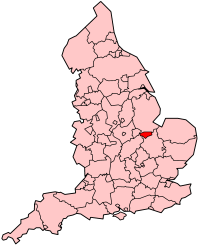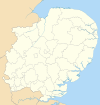Peterborough
| City of Peterborough | |
|---|---|

| |
| Geography | |
| Status: | Unitary, City (1541) |
| Region: | East of England |
| Ceremonial County: | Cambridgeshire |
| Area: - Total |
Ranked 140th 343.38 km² |
| Admin. HQ: | Peterborough |
| ONS code: | 00JA |
| Demographics | |
| Population: - Total (2005 est.) - Density |
Ranked 99th 165,000 463 / km² |
| Ethnicity: | 89.7% White 7.0% S.Asian 1.2% Afro-Carib. |
| Politics | |
 Peterborough City Council http://www.peterborough.gov.uk/ | |
| Leadership: | Leader & Cabinet |
| Executive: | Conservative |
| MPs: | Stewart Jackson, Malcolm Moss, Shailesh Vara |
Peterborough is a cathedral city and unitary authority in the East of England. For ceremonial purposes it is in the county of Cambridgeshire.
Peterborough Town Hall is located 73.7 miles (118.6 km) north from the centre of London at Charing Cross. The city is situated on the River Nene which flows into the North Sea approximately 30 miles to the north-east. The local topography is notoriously flat and low-lying, and in some places lies below sea-level. The area known as the Fens falls to the east of Peterborough.
The City of Peterborough includes the settlements of Wittering and Werrington and borders Northamptonshire, Lincolnshire, and Cambridgeshire.
History
Early history
The Romans first established the fort of Durobrivae in the vicinity around 43 AD which later grew into the town.
Peterborough (Burgh, Burgus sancti Petri) is proved by its original name Medehamstede to have been a Saxon village before 655 when Saxulf, a monk, founded the monastery on land granted to him for that purpose by Penda, king of Mercia. Its name was altered to Burgh between 992 and 1005 after Abbot Kenulf had made a wall round the minister, but the town does not appear to have been a borough until the 12th century. The burgesses received their first charter from "Abbot Robert" — probably Robert of Sutton (1262–1273).
Historically the dean and chapter, who succeeded the abbot as lords of the manor, appointed a high bailiff, and the constables and other borough officers were elected at their court leet, but the borough was incorporated in 1874 under the government of a mayor, 6 aldermen and 18 councillors. Among the privileges claimed by the abbot as early as the 13th century was that of having a prison for felons taken in the soke and borough. In 1576 Bishop Scamble sold the lordship of the hundred of Nassaburgh, which is coextensive with the soke, to Queen Elizabeth I, who gave it to Lord Burghley, and from that time until the 19th century he and his descendants, marquesses of Exeter, had a separate gaol in Peterborough for prisoners arrested in the soke.
Weaving
The trades of weaving and woolcombing were carried on in Peterborough in the 14th century. The abbot formerly held four fairs, of which two, one called St Peter's fair, granted in 1189 and later held on the second Tuesday and Wednesday in July, and the other called the Bridge fair, granted in 1439 and held on the first Tuesday, Wednesday and Thursday in October, still survive and were purchased by the corporation from the ecclesiastical commissioners in 1876.
Industrial revolution
One of the key points on the development of Peterborough was the decison to route the main east coast railway line through the city. As a result, Peterborough developed into an important railway hub. The railway, coupled with vast local clay deposits, enabled large scale brick making and distribution to take place. The Greater Peterborough area was the UK's leading producer of bricks for much of the 20th century.
Politics
Peterborough sent two members to parliament for the first time in 1547.
Modern history
Designated a "New Town" in 1968, Peterborough Development Corporation was formed in partnership with the city council to house London's 'overspill' population in new townships sited around the existing built-up area. There were to be four townships; at Bretton, Orton, Paston/Werrington and Castor. The last of these was never built, but instead a fourth township is now taking shape south of the city at Hampton. A new network of high-speed roads, known as 'Parkways' were constructed around the city. During the period between 1971 and 1991, Peterborough's population grew by 45.4%
Local government
From 1889 to 1965 the Soke of Peterborough formed an administrative county with boundaries similar, although not identical, to the current unitary authority. The Soke of Peterborough was merged with Huntingdonshire in 1965 to form Huntingdon and Peterborough.
On April 1 1974 Huntingdon and Peterborough was abolished and the current district was created by the merger of the Municipal Borough of Peterborough, Old Fletton urban district, Barnack Rural District, Peterborough Rural District, Thorney Rural District and part of Norman Cross Rural District. The newly created district became part of the non-metropolitan county of Cambridgeshire.
On April 1 1998 the city was given independence from Cambridgeshire as a unitary authority and continues to form part of that county for ceremonial purposes.
Transport
Peterborough is a major stop on the East Coast Main Line, and is 45-50 minutes journey time by rail from Central London with high-speed services from Kings Cross station operated by the Great North Eastern Railway company or slower services operated by WAGN.
Bus services are operated by the Stagecoach Group
Peterborough has a business airfield with a paved runway at Conington and a recreational airfield hosting a well-known parachute school at Sibson. It is a major railway junction where a number of cross-country routes converge. Central Trains operate the Liverpool to Norwich, Birmingham to Stansted Airport routes. Trains to Lincoln, a commuter stopping service to London via Hitchin as well as the high speed London to Yorkshire, Edinburgh and Newcastle lines also run through the city.
Despite its large-scale growth, Peterborough has one of the shortest local commute times for a city its size in the UK, thanks to the construction of the 'Parkways'.
Demographics
Today, Peterborough is a multi-cultural city, with significant Asian, Afro-Caribbean and Italian communities. As of 2005, the city had an estimated population of just under 165,000 with the estimated population of the entire Greater Peterborough area being well over half a million. Ethnic Groups: 140000 White, 7000 Pakistani, 2900 Indian, 12500 Other (Black, European, Other Asian ect.) (2005) (aprox)
Famous natives
'Nobby' the tramp
Andy Bell, the lead singer of the electronic pop band Erasure was born and spent his youth in Peterborough.
Peter Boizot, who founded the Pizza Express restaurant chain is also a well known Peterborian. He is well known for his support of the cultural and sporting development of the city.
John Clare, poet
Adrian Durham sports journalist and presenter on radio TalkSPORT
Keith Palmer better known as Maxim Reality, member of dance music band The Prodigy
Media
There is a major radio transmitter at Morborne, approximately 8 miles from Peterborough for FM radio. This facility includes a 163 metre high guyed radio mast which collapsed on October 30th 2004 after a fire and has since been re-built.
Peterborough has two local radio stations:
Hereward FM, named after legendary local Hereward the Wake, is the original station in the city and still holds a large section of the market. Bought from its original management, it became part of the GWR network which is now within the super-conglomerate GCap Media. Hereward FM broadcasts "today's best music" including pop and rock from the 80s, 90s and 00s. Hereward FM broadcasts on 102.7 FM, and is based in the Queensgate Shopping Centre.
Lite FM is Peterborough's second radio station and has struggled to gain listeners against Hereward FM. It broadcasts adult soft rock and pop on 106.8 FM and is staffed by a mix of full time staff and volunteers. Lite FM is currently located on Church Street on the top floor of the Northern Rock Building; it shares its offices with Creative Media Productions. Lite Fm was began broadcasting in the mid 1990s in fledgling form by founder Wayne Fitzgerald in his garage in a city suburb.
BBC Radio Cambridgeshire also has studios in the city, on Priestgate, broadcasting local output in place of the countywide programming on 95.7 FM at peak listening times.
Peterborough is also the home [1] of one the UK's largest media conglomorates, EMAP [2], whom have affectionately named Peterborough as 'Peterboghorror'[3].
Places of interest

Cathedral
Peterborough Cathedral is one of the most notable mediaeval cathedrals in the United Kingdom. The philosopher Richard Cumberland (1631–1718) became bishop of Peterborough in 1691.
One curious fact about Peterborough is that there is a church (St. John's) just outside the Cathedral in Cathedral Square. Why was a church built right next the cathedral? The reason for this is that at some point in history the monks of the abbey shut their doors to the general public which meant that they had to build their own church to worship in (the current St John's was consecrated in the early 15th century).
As the last resting-place of King Henry VIII's wife Catherine of Aragon, buried in Peterborough Cathedral, the city is twinned with:
 Alcalá de Henares, Spain (Catherine's birthplace)
Alcalá de Henares, Spain (Catherine's birthplace) Bourges, France
Bourges, France Forli, Italy
Forli, Italy Viersen, Germany
Viersen, Germany Vinnytsya, Ukraine
Vinnytsya, Ukraine
The cathedral was briefly the resting-place of a second Queen, Mary Queen of Scots. She was buried there in 1587. In 1612 her son King James - James 6th of Scotland and now also James 1st of England - had her body moved to Westminster.
Districts of Peterborough
- Bretton
- Dogsthorpe
- Eastgate
- Fengate
- Fletton
- Gunthorpe
- Hampton
- Longthorpe
- Millfield
- Netherton
- New England
- The Ortons
- Paston
- Ravensthorpe
- Stanground
- Walton
- Werrington
- West Town
- Westwood
- Woodston
Villages in the District
- Barnack
- Eye
- Glinton
- Marholm
- Milking Nook
- Northborough
- Peakirk
- Sutton
- Thornhaugh
- Thorney
- Upton
- Wansford
External links
- http://www.ycp.info - The Young People's Office (Young people involved in decision-making)
- http://www.peterborough.gov.uk/ - Peterborough City Council
- http://www.peterboroughheritage.org.uk/ - For the Peterborough Museum, Libraries and Archives service.
- The Cambridgeshire (City of Peterborough) (Structural, Boundary and Electoral Changes) Order 1996 - which formed Peterborough unitary authority.
- Guide to Peterborough Local Studies Collection - gives some history of administrative changes.
- 2001 Census
- Peterborough Cathedral

